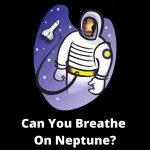No, you cannot breathe on Pluto.
In the article that follows, we’ll explain.
Can You Breathe On Pluto? (EXPLAINED)
Relevant Facts About Pluto
Pluto was discovered only in the last 100 years.
While many of us learned about Pluto as the 9th planet while in primary school, it has been relegated to the status of “dwarf planet” because of it’s size.
We know that Pluto has a solid rocky crust, but argue amongst ourselves about whether the core of Pluto is warm or icy.
The gravity on the surface of Pluto is quote a bit less than we have on Earth, only about 1/15th.
There is little atmospheric pressure on the surface of Pluto.
The atmosphere (what little there is) is really thin.
What does exist is mostly nitrogen, with a little methane and carbon dioxide.
The gaseous molecules probably started as ice on the surface of the planet, and were vaporized into the atmosphere.
Relevant Facts About Human Respiration
Humans need to breathe the right amount of oxygen to live.
If a human body does not get enough oxygen, the body doesn’t work right and the human loses consciousness or even dies.
If a human body gets too much oxygen, he won’t necessarily pass out or die like he would if he didn’t get enough oxygen.
But too much oxygen over time can cause permanent damage to internal structures and tissues in the body.
Whether you could breathe on a specific planet is also governed by the pressure on the lungs/body, as well as the air temperature.
The air can’t be too cold; otherwise the human tissues can be damaged by breathing it.
Why Can’t Humans Breathe On Pluto?
There’s lots of ways a human could die on Pluto trying to breathe.
Cold, radiation, lack of atmospheric pressure, solar winds, etc, etc, but the main reason we can’t breathe on Pluto is that there isn’t any oxygen in Pluto’s atmosphere.
Humans need to breathe oxygen to survive, and since there isn’t any oxygen available, breath isn’t possible.
People will argue about whether it is possible to draw a breath on Pluto even though the air won’t support human life.
We would argue that it probably isn’t possible to draw a breath.
The atmosphere around Pluto is extremely thin.
Like extremely thin.
The atmospheric pressure is like 1/100,000 of that around Earth.
There just aren’t that many molecules around the planet.
Pluto isn’t a vacuum (like in open space), but it is pretty darn close.
If a human tried to take a breath (temperature concerns aside), the body would probably react similarly to how it would if you were kicked out of the ship in open space.
Breathing On Other Planets
While it may be possible to find ways to live on other planets in our solar system, there is not a single planet aside from Earth that has an atmosphere that we humans can breathe.
Some planets just don’t have enough oxygen.
Some of the atmospheres of other planets are downright toxic/poisonous to us.
So far, all of our plans for colonization will have to include breathing/life support.
Did You Know? (Other Facts About Pluto)
Here are some facts you may not have known about Pluto:
- Pluto is about 3.7 billion miles from the sun. Earth is relatively close to the sun in comparison, a paltry 91 million miles away.
- It takes Pluto around 248 Earth years to orbit the sun one time. Since Pluto was first discovered (and we’ve started paying attention to it), Pluto has not even made it around one time. To compare, Mercury makes one trip around the sun every 88 Earth days.
- Pluto is small and spins very slowly. It is 1/6th of the size of Earth, and still takes 6 Earth days to rotate fully one time.
- Pluto might be losing its atmosphere. The theory is that Pluto’s atmosphere from gases changing phase (from solid to liquid to gas). As Pluto moves away from the sun in its orbital path, the surface of the planet is getting colder, and some of those gaseous molecules are slowly down and returning to a more solidified state. The thinner the atmosphere gets, the colder the planet gets, and the more of the atmosphere is lost to ice. It is thought that the atmosphere will return over time as the planet moves into an orbital area that is closer to the sun.
- While Pluto is smaller than Earth’s moon, it still manages to have some moons of its own, Charon, Styx, Nix, Hydra, and Kerberos.
- Scientists believe that they have found evidence of geological changes on the surface of Pluto, which may indicate that Pluto has a molten core. Pluto may not be quite as cold as people think.
- The escape velocity on Pluto is not significant, but it is enough to keep a human from jumping off the planet during a space walk.
- The average surface temperature on Pluto is in the range of minus 380 degrees Fahrenheit.
- Pluto is located in the Kuiper Belt, which is a region of millions of icy solid objects probably left over from the formation of our solar system on the far side of Neptune’s orbit around the sun. There may be objects big enough in the Kuiper Belt to warrant planet status in our solar system.
Wrap Up
Pluto is a fascinating planet, and we look forward to learning more about it as the progress of space exploration continues.
You might also enjoy:
- USVAO Pluto Articles Library
- Can You Walk On Pluto?
- Can You Breathe On Titan?
- Can You Breathe On Triton?
- Can You Breathe On Mercury?







